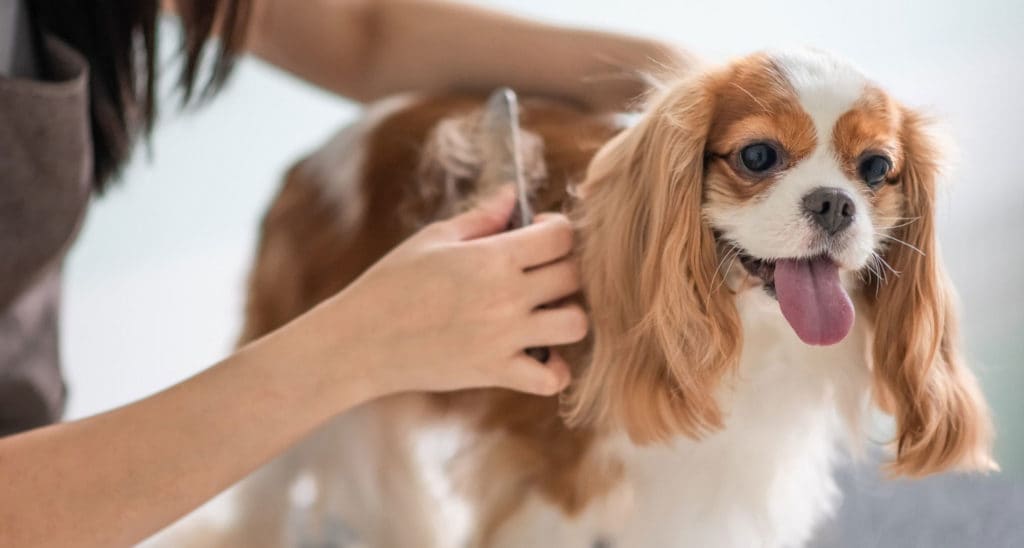Grooming is part of basic pet care, and doing it regularly not only keeps your best four-legged friend looking good, but will keep him in good health too. Regular grooming will familiarize you with your pet’s body and alert you to any changes or abnormalities immediately—and help you both strengthen your bond for life.
Taking your pet to a professional groomer is certainly the easiest way to keep your pal’s coat and skin in great shape. But professional groomers can also be expensive and if your pet is not entirely comfortable with strangers, he may prefer your personal touch anyway. With our expert tips below, and guidance on which tools and products are worth your hard-earned money, you can feel confident about taking care of your pet in the comfort of your own home.
Brushing Their Coat
Brushing your pet’s coat is something that you can do often, as frequently as every couple of days if you can manage it. Brushing is an essential step in grooming both cats and dogs, as it removes excess hair, pulls out and detangles matted fur, and helps evenly distribute the natural oils in your pet’s skin and coat to keep it looking shiny and healthy. Brushing may also increase blood flow to the skin’s surface and help reduce shedding too.
Giving Your Pet a Bath
Your dog needs to be bathed about every 2–4 months. That is, of course, unless they get into something particularly dirty or smelly. Barring any unexpected messes, you can plan to keep bathing to a minimum, as bathing too often can actually have a negative effect on your pet—stripping his skin of the natural oils that protect and soften his coat and drying out his skin.
Another way to prevent dry or irritated skin is to use a specialized pet shampoo. Many pet-friendly products are made to be hypoallergenic and gentle on your pet’s sensitive skin or contain antiseptic and antifungal ingredients—helpful if your pup tends to get incredibly messy on the regular.
Dental Health and Care
You might not realize your pet’s teeth need regular attention too, but he can suffer from many of the same dental problems as you, including tartar buildup and gum disease. There are many kinds of dog dental treats and cat dental treatsyou can give regularly that your pet will enjoy, and will also protect their teeth from that unwanted tartar and dangerous bacteria buildup.
Trimming Nails
Trimming your pet’s nails might feel like an unpleasant task, but it’s just as important as brushing and bathing. If nails are allowed to grow too long, they begin to curve over, possibly causing your pet’s toes to splay out awkwardly when walking or running, which can potentially lead to injury.
To prevent this, trim your pal’s nails with a tool designed specifically for your pet. Trimmers will vary slightly in size and style depending on whether they’ve been made with dogs or cats in mind. Cat and dog nail clippers are also created with the animal’s size in mind, so choosing the proper tool is crucial.
Keeping Your Pet Calm
If your pet is often nervous or anxious, especially when he sees the pet grooming tools come out, there are a few things you can do to calm and reassure him. Training can help your pet become more comfortable with being touched in the sensitive areas that often need to be handled during a grooming session, like the tail, paws and face. To ease your pet into the practice of being touched in these sensitive places, start by touching a less delicate place on his body, like his back or shoulder, and gradually move your hand to the more sensitive spot, like the paw. You may need to practice doing this many times before your buddy becomes more comfortable.
Another way to make your pet less scared of grooming is to get him to associate this time with a treat (or something else equally pleasant). Even if you’re only able to brush him for a short time or clip a few nails before he starts to wiggle, give him a treat right away so he begins to understand that sitting calmly during the grooming process gets him a tasty treat. If he becomes nervous after a few minutes, allow your pet plenty of time to calm down before giving it another go.
By: Chewy Editorial
Share:













